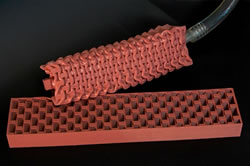New Muscle-Inspired Actuators Hold Potential to Build Safer, Soft-Bodied Robots
 Robots should be safer and softer in order to make them more cooperative and execute tasks in close contact with humans. George Whitesides, Ph.D., a Core Faculty member at Harvard’s Wyss Institute for Biologically Inspired Engineering and the Woodford L. and Ann A. Flowers University Professor of Chemistry and Chemical Biology in Harvard University’s Faculty of Arts and Sciences (FAS), along with his team, has created a new actuator that moves like human skeletal muscles by using vacuum power for automating soft, rubber beams.
Robots should be safer and softer in order to make them more cooperative and execute tasks in close contact with humans. George Whitesides, Ph.D., a Core Faculty member at Harvard’s Wyss Institute for Biologically Inspired Engineering and the Woodford L. and Ann A. Flowers University Professor of Chemistry and Chemical Biology in Harvard University’s Faculty of Arts and Sciences (FAS), along with his team, has created a new actuator that moves like human skeletal muscles by using vacuum power for automating soft, rubber beams.
These actuators are soft and shock absorbing similar to real muscles, and do not pose any danger to their surroundings or the human beings working along with them or the future robots containing them. This study was published in the June 1 issue of the Advanced Materials Technologies journal. Cont'd...
Comments (0)
This post does not have any comments. Be the first to leave a comment below.
Featured Product

